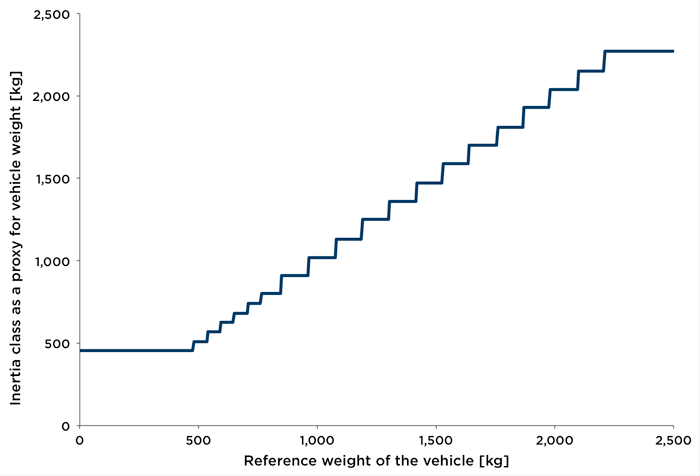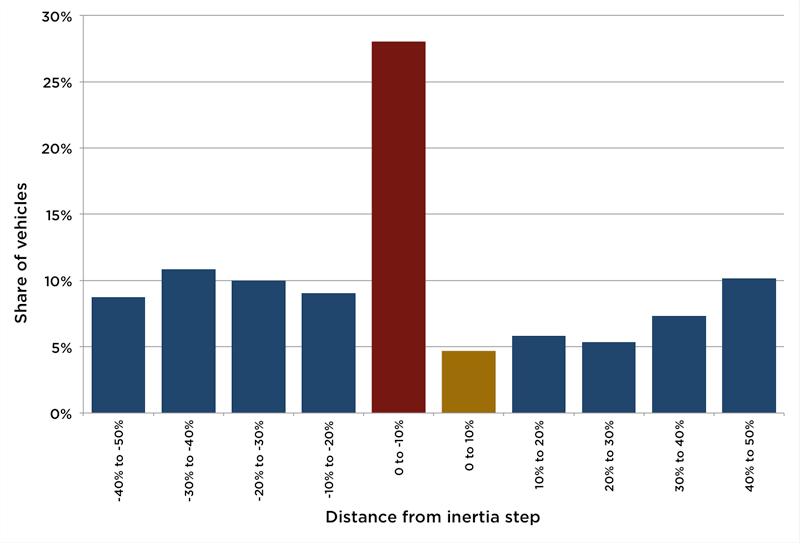Blog
Inertia classes, vehicle emissions tests, and the dead hand of the past
Test procedures are a key feature of any system of regulating vehicle emissions. Vehicle emissions testing* involves running a vehicle on a chassis dynamometer, which (among other things) simulates the inertia of the vehicle driving on a road. Most governments that regulate emissions define a series of inertia classes or “steps” for testing, for reasons explained below; the U.S., Europe, and Japan are examples. But in the digital era this is an anachronism, kept in place by force of habit rather than force of logic. And it has the bad effect of allowing manufacturers, if they wish (and some do), to portray specific vehicle models as less polluting and more fuel efficient than they really are.
Setting up a mechanical dynamometer involves using physical weights (a flywheel) to simulate the inertia weight of the vehicle (since, of course, the engine doesn’t have to work to overcome actual inertia because the vehicle doesn’t actually move). In an era when mechanical dynos were the only option, this effectively forced the use of inertia classes so that weight could be added/subtracted in practical increments: the same physical weight is used to set up the dynamometer for testing all vehicles in a single class. It also imposed an upper limit on simulated inertia weight, as too heavy a rotating inertia mass can damage a dyno. Of course, the weights of actual vehicles don’t vary in regular increments, but more-or-less continuously. For testing purposes, a vehicle is run on a dyno set up with the specified weight for the inertia class to which it belongs, but its actual weight may be greater or lesser. In other words, when measuring vehicle emissions, testing uses an approximation of vehicle inertia mass, not actual vehicle inertia mass. The weight categories, or inertia class steps, typically vary between 55 kg and 250 kg, depending on the weight of a vehicle and the respective region (Europe, Japan and the US make use of different inertia steps). Figure 1, to give a specific example, graphs the inertia steps for the European Union.
A change in the weight of a vehicle of 10 to 30 kg is typically associated with a change in CO2 emissions of 1 g/km (the exact value depends on the test cycle and upon secondary weight effects). Because the actual weights of the vehicles in a given inertia class may vary much more than that, so will their actual CO2 emissions—between 4 and 8 g/km, in practice.
Why is this important? Simply put, because it creates an incentive for manufacturers to squeeze into a lower inertia class. Vehicles at the upper boundary of an inertia class are tested on a dyno simulating less inertia weight than the vehicle’s engine must overcome in real-world operation on the road. The engine therefore can work less hard, burn less fuel, emit fewer pollutants, and so get credit on paper for lower CO2 emissions and fuel consumption values. It’s a little like a boxer or a wrestler sweating in a sauna to drop half a pound and move down a weight class to be able to fight much smaller opponents. Similarly, a manufacturer can increase the weight of a vehicle model (by, e.g., adding optional equipment) without the resulting increase in actual CO2 emissions and fuel consumption being reflected in the vehicle test results, as long as the vehicle remains within the same class.
An analysis of recently released data from the European Commission’s CO2 monitoring (European Environmental Agency,
As it happens, the simplest way to deal with this method of gaming the system would be to change the system. Modern dynamometers can simulate any vehicle weight—no more need for the physical weights of rotating inertia masses, and no more rationale for a system of inertia classes based on the practical need to limit those weights to a manageable number. The current step-based system is obsolete. It could be replaced by a more accurate, step-less approach using actual vehicle weight, and it should be.
A proposal which would do exactly that is under discussion as part of a project sponsored by the United Nations Economic Commission for Europe to develop a worldwide harmonized test procedure for light-duty vehicles (WLTP). For more detail, see the ICCT working paper series on the WLTP here.
*For fleets, not an individual vehicle (such as might be required annually to renew your license tags).


